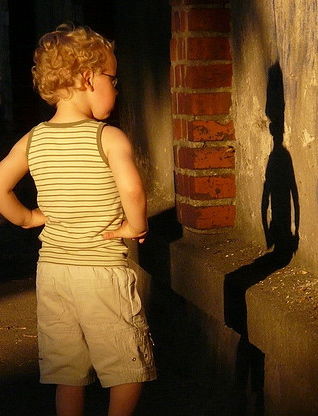Imaginary Friends
Those pals may help kids cope in times of stress.
Posted January 31, 2013 Reviewed by Devon Frye
Key points
- By age 7, about 37 percent of children take imaginative play a step further and create an invisible friend.
- Children with imaginary companions tend to be less shy, laugh more with peers, and are better at imagining how someone else might think.
- Asking a child questions about their imaginary friend can reveal more about the child's interests, wishes, fears, or concerns.

A friend told me that she once had a moment of sheer terror in her own driveway. Her three kids were sitting in the back seat of the car. She was backing out of the driveway, when suddenly her youngest daughter, who was four at the time, screamed in fright, “Stop!”
My friend slammed on the brakes. With her heart in her throat, she looked around frantically, trying to spot the danger. “What?” she asked urgently. “What is it?!”
“You almost ran over Boopsie!” her daughter exclaimed.
Boopsie was her daughter’s invisible friend. Fortunately, after a few moments, Boopsie had moved out of the way, and they were able to proceed. It took a bit longer for my friend’s heart rate to settle.
How common are invisible friends?
Most young children play pretend games and interact with their stuffed animals, dolls, or other special toys as if they were alive. According to Marjorie Taylor and her colleagues at the University of Oregon, by age 7, about 37 percent of children take imaginative play a step further and create an invisible friend.
The variety of forms that invisible friends come in is a testament to the power of imagination. Tracy Gleason and her colleagues cite these examples from their research on invisible friends.
- Star Friends and Heart Fan Club: “Groups of preschool-aged human friends with whom the child had birthdays, went to the fair, and spoke a language called Hobotchi.”
- Herd of cows: “Cows of many colors and varying sizes who were often fed or diapered like infants. Discovered when the child’s father accidentally stepped on one.”
- Maybe: “A human of varying gender whom the child routinely summoned by shouting out the front door of the family’s house.”
As these descriptions show, invisible friends can be human, animal, or fantasy creatures. They may appear alone or in groups. In past research, boys have been observed inventing only male imaginary friends, whereas girls have either male or female ones.
Children with invisible friends can readily describe what these friends look like and how they behave. Many children even offer details about hearing or touching their invisible friends. Invisible friends can sometimes be a part of the life of a child—and a family—for years.
Taylor and her colleagues found that children who create a friend out of a personified object tend to have a parent-like relationship with their special toy friend, whereas children with invisible friends tend to imagine an egalitarian relationship, more like a real friend.
Like real friends, invisible friends don’t always cooperate! Taylor and her colleagues found that about one third of children with invisible friends complained that their invisible friend didn’t always come when called, didn’t leave when asked, talked too loudly, didn’t share, or did annoying things like “put yogurt in my hair.”
Children vividly experience interactions with their invisible friends, but they almost always know that these friends aren’t real. Looking at transcripts of interviews of 86 children with invisible friends, Taylor and her colleagues found that 77 percent of these children said “yes” when asked if they had a pretend friend, and 40 percent spontaneously remarked at some point during the interview that they were talking about a pretend friend. The children offered statements such as, “Her is a fake animal,” “I just made him up in my head,” and “He’s not in real life.” Only one child was adamant that her invisible friend was real.

On the other hand, invisible friends are an especially compelling and involved form of pretend play. My friend’s daughter was genuinely upset at the prospect of her invisible friend getting run over. Perhaps invisible friends represent “bemagination”—something partway between belief and imagination.
Surprisingly, invisible friends don’t necessarily disappear when childhood ends. One study that examined the diaries of adolescents plus questionnaire data concluded that socially competent and creative adolescents were most likely to create an imaginary friend and that this type of friend was not a substitute for relationships with real people. Adult fiction writers often talk about their characters taking on a life of their own, which may be an analogous process to children’s invisible friends.
Why do children invent invisible friends?
It seems logical that children who invent invisible friends might be lonely or have social problems, but research doesn’t support those assumptions. In fact, compared to those who don’t create them, children with imaginary companions (either invisible friends or personified objects) tend to be less shy, engage in more laughing and smiling with peers, and do better at tasks involving imagining how someone else might think.
Oldest children, only children, and children who don’t watch much television are more likely to create an imaginary friend. This probably reflects opportunity. Children need unstructured time alone to be able to invent imaginary friends.
Having an imaginary friend is not evidence that a child is troubled. However, imaginary friends can be a source of comfort when a child is experiencing difficulties. There are many case studies of children inventing imaginary friends to help them cope with traumatic experiences. A study based on interviews of middle school students at high risk for developing behavior problems found that having an imaginary companion was associated with better coping strategies but lower social preference with peers. However, by the end of high school, those high-risk children who had had an imaginary companion in middle school showed better adjustment on multiple measures.
At a more mundane level, children with imaginary friends sometimes blame them for misbehavior in an attempt to avoid parental displeasure. Imaginary friends can also help children to cope with fears, explore ideas, or gain a sense of competence through learning from or taking care of the imaginary friend.
How should you respond?
If your child has an invisible friend, relax and enjoy it. Ask questions to find out more about the friend. You may learn something about your child’s current interests, wishes, fears, or concerns. You may even want to write down and save your child’s adorable answers.
It’s okay to lay down the law if the imaginary friend’s demands or “behaviors” become too disruptive. Without harshly challenging the existence of the friend, you can say things like, “I don’t care who made this mess. You need to wipe it up” or “Aunt Carol is coming in the car with us, so Mr. Murf will have to find somewhere else to sit today.”
On the other hand, if it’s not too much trouble, go ahead and play along. Set an extra place at the table for the imaginary friend, if your child asks you to do so, but be careful not to take over. An imaginary friend is a unique and magical expression of your child’s imagination, so let your child be in charge of it.
Facebook/LinkedIn image: aldegonde/Shutterstock
References
Gleason, T. R., Sebanc, A. M., & Hartup, W. W. (2000). Imaginary companions of preschool children. Developmental Psychology 36, 419-428.
Seiffge-Krenke, I. (1997). Imaginary companions in adolescence: Sign of a deficient or positive development? Journal of Adolescence, 20, 137-154.
Taylor, M., Shawber, A. B., & Mannering, A. M. (2009). Children’s imaginary companions: What is it like to have an invisible friend? In K. D Markman, W. M. P. Klein, & J. A. Suhr (Eds.), Handbook of imagination and mental simulation (pp. 211-224). NY: Psychology Press.
Taylor, M., Carlson, S. M., Maring, B. L., Gerow, L., & Charley, C. M. (2004). The characteristics and correlates of fantasy in school-age children: Imaginary companions, impersonation, and social understanding. Developmental Psychology, 40, 1173-1187.
Taylor, M., Carlson, S. M., & Shawber, A. B. (2007). Autonomy and control in children’s interactions with imaginary companions. In I. Roth (Ed.), Imaginative Minds. Oxfore: British Academy and Oxford University Press.
Taylor, M., Hulette, A. C., & Dishion, T.J. (2010). Longitudinal outcomes of young high-risk adolescents with imaginary companions. Developmental Psychology, 46, 1632-1636.
Taylor, M. (1999). Imaginary companions and the children who create them. Oxford: Oxford University Press.
Taylor, M. & Mottweiler, C. M. (2008). Imaginary companions: Pretending they are real butd knowing they are not. American Journal of Play, 1, 47-54.


















